Ground Reports
New Homes, Same Old Problems: Who's Failing Delhi’s Slum Rehabilitation Projects?
Ankit Saxena
Jun 30, 2025, 02:03 PM | Updated Aug 03, 2025, 09:47 PM IST
Save & read from anywhere!
Bookmark stories for easy access on any device or the Swarajya app.
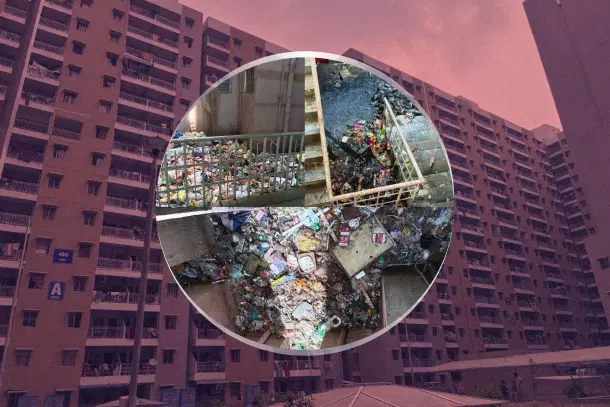

In January 2025, 1,396 families living in the slum clusters in Delhi were handed over the keys to their new flats in 'Swabhiman Apartments' in North West Delhi’s Ashok Vihar, as part of the rehabilitation initiative by the Delhi Development Authority (DDA).
The newly built high-rise complex, consisting of 1,675 homes, was inaugurated by Prime Minister Narendra Modi, with keys handed to families who had been waiting for this moment since filing for allotment two years ago.
The residents began moving into their new homes in March and April. However, just two months after the residents moved in, waste management became a major issue, and most open spaces within the housing complexes have turned into dumping grounds.
The problems have only worsened over time, and a recent video showed the deteriorating conditions within these buildings.
Over the past month, Delhi has seen a series of demolitions of several slum clusters and informal settlements, including those that had expanded onto railway land.
These actions have stirred debate and at the centre of the discussions is a central government initiative “Jahan Jhuggi Wahan Makaan”, which means in-situ rehabilitation, or providing people homes on the same land.
The scheme has been central to Delhi’s slum rehabilitation efforts, as it aims to provide dignified housing with basic infrastructure for economically weaker sections of society, as well as remove the challenge of displacement. This approach allows people to remain where they have built their lives, avoiding disruption to their livelihoods and social ties.
The Swabhiman apartments were also built under the same scheme, providing houses to slum dwellers from Jailorwala Bagh and Golden Park Rampura.
The project was first tendered in 2014, but construction only began in 2017. It was supported under the In-Situ Slum Rehabilitation (ISSR) programme of Pradhan Mantri Awas Yojana-Urban (PMAY-U).
The project is located on DDA land measuring 34,594.74 sqm, with a total construction cost of ₹421 crores (excluding the cost of land). Eligible beneficiaries were required to pay less than 7 per cent of the total cost, which included ₹1.42 lakhs as contribution for the unit and ₹30,000 for five years of maintenance.
Each flat has a carpet area of 31 sqm — one living room, one bedroom, a bathroom, a kitchen, and a balcony. The facilities are on par with the amenities found in other high‑rise developments — in affordable or standard apartment complexes (not in premium or luxury projects) across Delhi NCR.
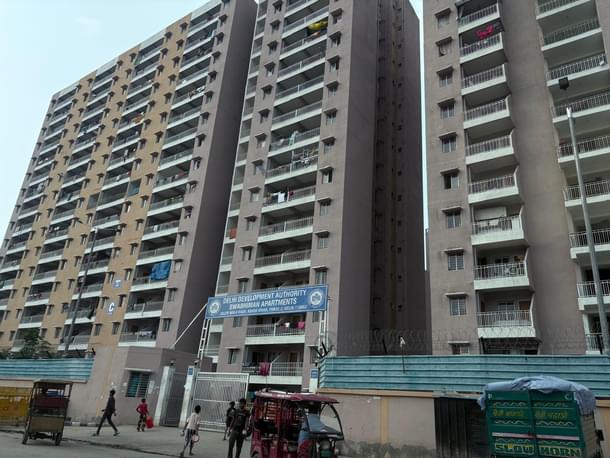
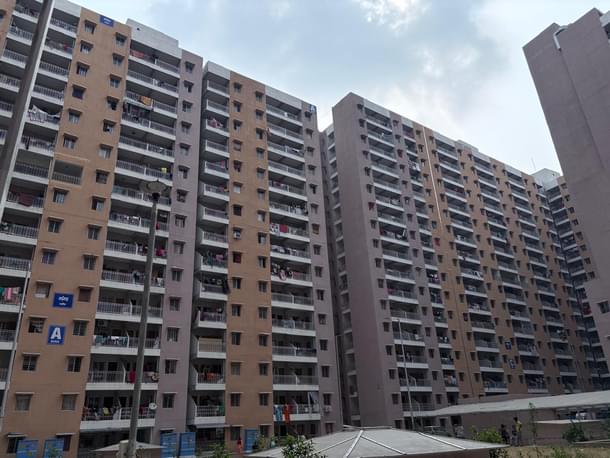
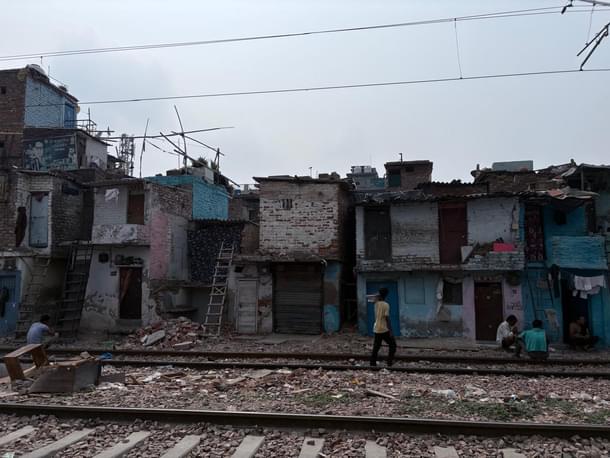
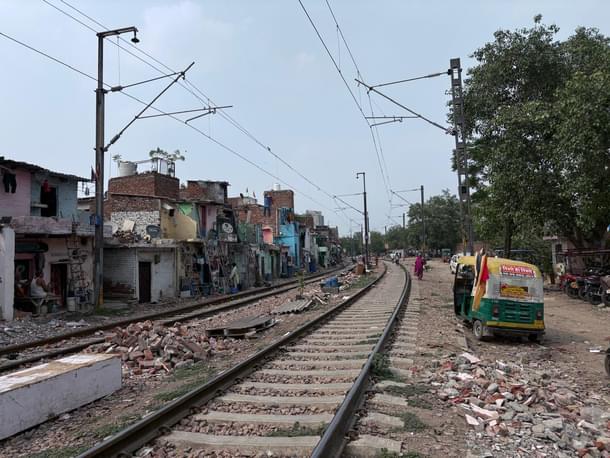
However, this issue of waste dumping within the apartments brings out deeper concerns of rehabilitation, which extend beyond merely providing infrastructure, and into how people adapt and make use of these spaces.
It is important to ask why such a situation has occurred, especially with the recent demolitions and demand for more such rehabilitation programmes. Despite the huge resources invested, this is not how rehabilitation was meant to work.
The goal of improving people’s lives is not being met, and if this trend continues, these formal housing projects could end up facing the very problems they were meant to solve.
Who Is At Fault?
The complex comprises three high‑rise towers, with almost all the ground floors flooded due to water leaking from the clogged shafts. The staircases and lift lobbies have also become dumping spots, with garbage piling up in the corners and spreading across the common areas.
According to the residents, in many areas of the complex, construction materials were left piled up in corners.
“When people started moving in, some construction materials were still scattered near staircases. The authorities never cleaned it up before handing over the buildings,” a group of residents tells Swarajya.
However, on visiting the complex, it was not just leftover construction materials causing concern — alcohol bottles, wet waste, garbage, broken furniture, and discarded clothing were visibly piled up at nearly every corner.
While it is common practice to hold authorities responsible for any action affecting the urban poor, this reaction often deflects ground realities. As a result, the root causes are ignored, and the same problems keep coming back. It is vital to identify where these amenities are disregarded which is creating setbacks for these efforts.
Many residents agree with this too. While some waste was left behind when the flats were handed over, it has been compounded by more waste dumped by residents after they moved in.
“It’s also the residents themselves who have added to the problem. We try to make them aware, but it’s challenging to control so many people who have just shifted from slums,” says Dilip, a social worker active in helping the slum dwellers in rehabilitation.
“They continue to follow old habits from the jhuggis, instead of understanding that this change is a chance to build a better life,” he adds.
It is not realistic to expect the people living in slum clusters for decades to adjust to a formal housing complex from day one. But it becomes a challenge when, despite awareness campaigns and efforts by many volunteers, old habits continue.
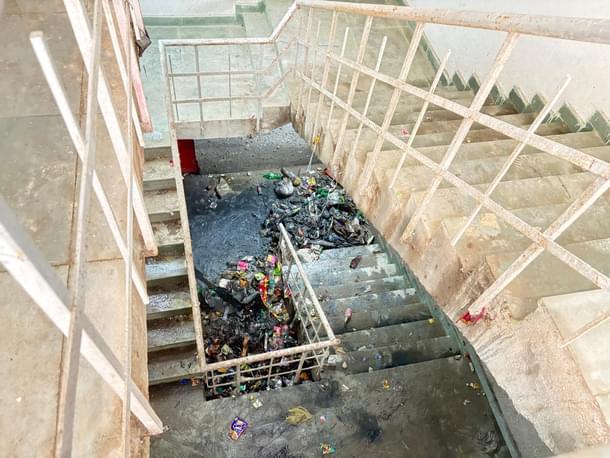
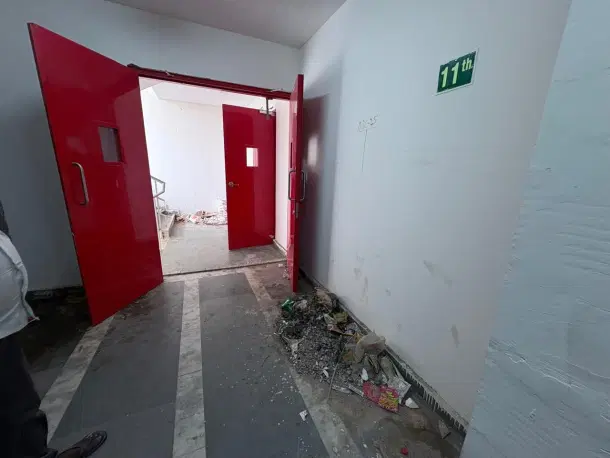
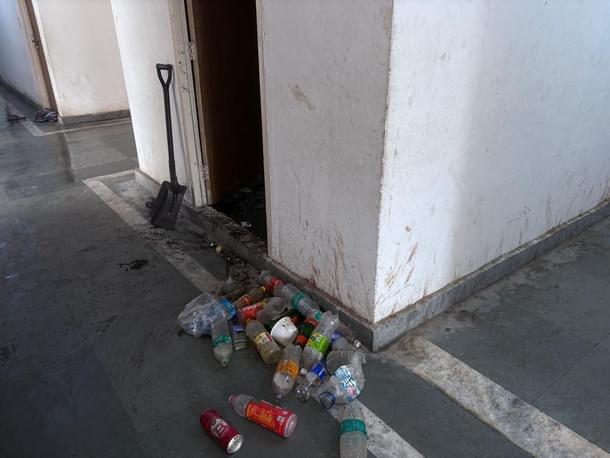
In several such colonies, developed under PMAY or before, in Chandigarh, Solapur, Mumbai, and Delhi, not everyone finds it easy to adapt to the rehabilitation initiatives. While people start to stay in slums out of lack of choice, the informal arrangements to access basic resources, as well as challenges related to work, make it difficult to get out of the slum culture.
Inside the Swabhiman apartments, a garbage truck comes every morning. Residents are supposed to go down and dispose of their trash properly. If they miss the truck, they can later take their garbage outside the complex.
However, not everyone follows this simple system. Some residents throw their garbage into common areas, while others living on higher floors throw it down plumbing shafts directly from their homes.
Others also try to toss their garbage over the compound wall. As a result, bags of waste can be seen hanging from the fencing on top of compound walls. Meanwhile, stairways, lift lobbies, and common spaces on each floor are littered with wrappers and discarded packets.
On one occasion, while workers were cleaning out the shafts clogged with waste thrown by residents and taking measurements to fence the openings, a few ladies came to ask why they were blocking it, concerned about where to dispose of their garbage once it was closed.
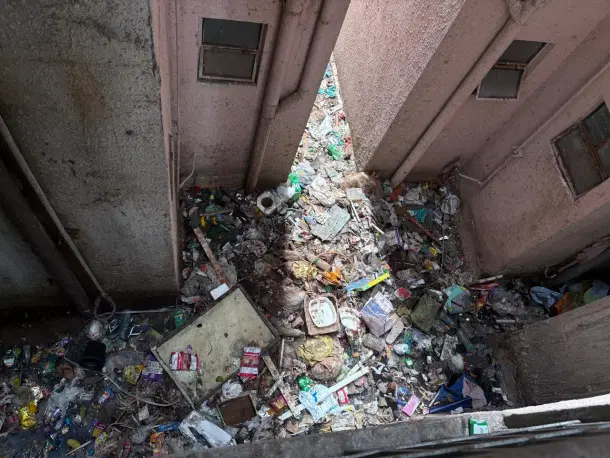
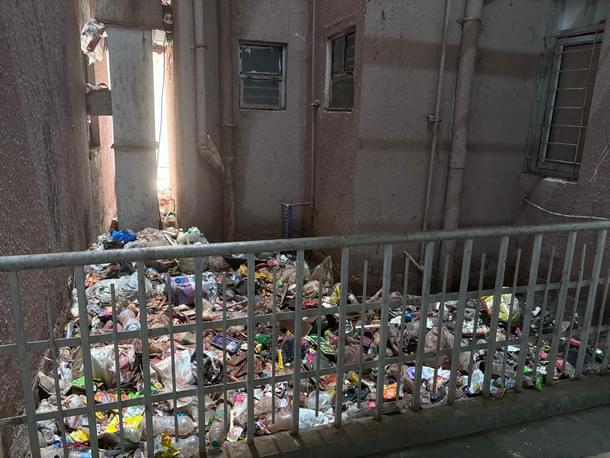
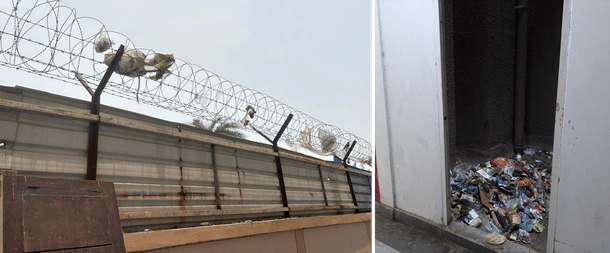
Those Looking to Change Are Also Getting Troubled
As a result, the entire rehabilitation complex is affected, including those residents who are putting in efforts to make the most of these new housing opportunities. This also surfaced in one block where a resident was seen arguing with a few of his neighbours over waste disposal.
“The corridor has many homes. It’s our responsibility to keep the area in front of our doors clean and to work together to maintain the shared corridor,” says Rajesh Kumar, who grew up in the Jailorwala Bagh slums and now works at a private firm.
“But not all are doing this. Just like in the slums, they only clean the area right in front of their own door, leaving the waste in the corridor. Who is supposed to clean that? It is a responsibility we all have to share, and not the DDA,” he adds.
“I try to make people aware at least in this corridor, but most of the time it only ends up in arguments with no outcome,” he adds.
Even as Rajesh and others like him do their best to dispose of waste, they are also worried about the growing piles of garbage in the common spaces. The residents on the lower floors suffer the most from this waste dumping and leakages on the ground.
While speaking with residents on the upper floors, they say that most lifts have been damaged by miscreants. There are also videos of outsiders entering the building and vandalising the lifts. So many have taken this as a reason for throwing waste into shafts.
Further, it is not just regular garbage. As people moved in, they were supported with transporting their belongings. They brought everything with them — broken doors, windows, worn-out mattresses, electronics. But when those did not fit or were not usable, it was just dumped down the shafts and in open spaces.
This careless dumping also damaged the pipelines. The debris jammed the waste shafts at the bottom, leading to overflows from broken pipes, creating further sanitation and maintenance problems.
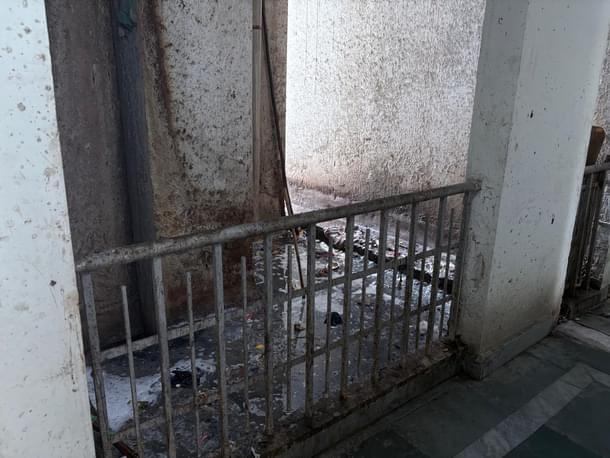
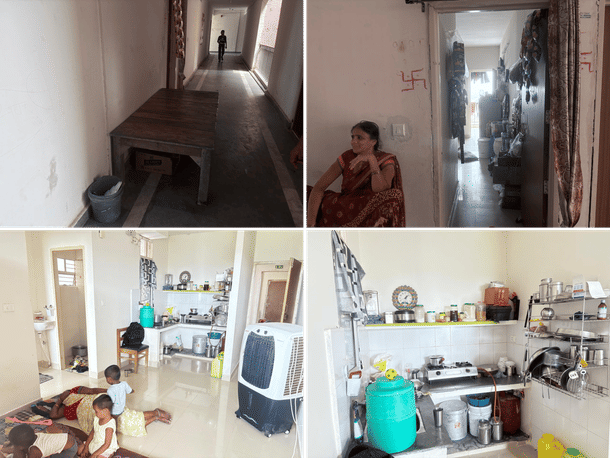
How Are Authorities Dealing with This?
Officials from the DDA state that when residents were first relocated, several awareness campaigns were conducted with the help of NGOs to educate people about waste disposal and other maintenance practices.
As waste disposal issues grew, DDA officials also started conducting their own awareness drives through appointed staff and security guards.
The maintenance of the complex is the responsibility of the DDA. The door-to-door awareness did not help much, and waste dumping continued to rise each day.
“Many guards have had to deal with intoxicated residents, and a lot of people refused to listen or cooperate when asked not to dump waste carelessly.”
While several staff members were seen cleaning, till now they only managed cleaning the outside areas of the buildings, and did not take any other actions to control this situation.
The authorities continued to receive information from guards and staff, including photographs and videos of vandalism, but in many cases, they were minors who were only given warnings.
Only now is the number of cleaning staff being increased as the problem continues to grow, and there is no other option but to remove the piles of waste before it leads to further challenges and complaints.
What Needs to Be Done Early
While efforts have succeeded in fulfilling the essential need of decent shelter for slum dwellers, the emerging situation shows the need for added steps for housing management to sustain these rehabilitation efforts.
To not make the situation worse and to bring in some rules, early steps are needed specific to this housing, which can also be considered for future such initiatives.
One, setting up the Resident Welfare Association (RWA) should have been a priority from the outset, like for any group housing, to supervise and monitor day-to-day issues which remain scattered presently.
This is also required for the resident body to take responsibility and be held accountable if problems continue, unlike the current situation, where the issues are passed around in a cycle of blame among the residents.
Dilip tells Swarajya, “We are working towards forming the RWA as soon as possible and putting things in order. An earlier attempt to create one ended in a bitter exchange between parties and was abandoned.”
However, officials state that this will have to be done formally through the district magistrate, as it will be vital to have the right people in charge — people who will understand the changes and standards of a group housing complex, and guide all residents.
Two, residents have to recognise that this shift from a slum to formal housing comes with basic responsibilities. Public meetings are needed to help people understand the differences, making them build better civic habits.
In independent dwellings, a person only needs to worry about their own space. But in a group housing complex, maintaining common areas like corridors, staircases, lift lobbies, and open spaces — everyone has a role to play, like how other standard high-rise apartments in the city maintain cleanliness and order.
Three, enforcement of strict rules and fines on those not following the rules. Once the RWA is formed, it will establish clear rules based on the issues that have emerged in the first two months.
“These rules will be communicated to everyone — through meetings, notices, and even door-to-door instructions,” Dilip adds.
Some residents agree that penalties must be introduced for those who do not comply.
“At first, warnings can be issued during general meetings, and if the behaviour continues, we will impose fines. That is the only way,” they add.
Four, beyond the residents, there is still a need for attention in terms of housing management from the authorities. The residents stress that improvements will need the support of the authorities and the government to manage the place better.
Since maintenance remains under the DDA, the authority has doubled the number of dustbins from the original plan. This will make the bins more visible and accessible to people to dispose of waste properly. Moreover, the number of workers assigned to cleaning has also been doubled, until the situation improves.
Five, there is also an urgent need for stricter policing to prevent damage to the infrastructure and services, which only worsens the cleanliness issues.
Around 5,000 people live in the complex, with no regulations or monitoring of who enters and exits. Several of the problems from the slums — like public drinking, fighting, and abuse by habitual offenders — still happen in the complex.
This makes police attention essential, with a shift in their perception of former slum dwellers, to ensure this area does not become another neglected space. The DDA has stated that it has submitted a proposal to set up a dedicated police post within the complex.
According to recent updates, nearly 200 more units in the same complex have been allotted, with the new beneficiaries expected to move in soon. As per this report, currently, about 20 per cent of Delhi’s population, roughly 50 lakhs, live in more than 675 slums, many of whom need rehabilitation.
This makes it important to put strong systems in place, to ensure accountability not just from authorities but also from the residents, before we move ahead with rehabilitation projects.





